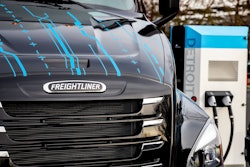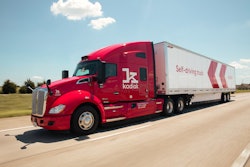
Kenworth’s Sean Henebry and Volvo’s Duane Tegels tried to provide some clarity around the expansive and complicated regulations California’s Air Resources Board (CARB) will impose on the trucking industry operating in the state in 2024 during the Used Truck Association (UTA) Convention Thursday in San Antonio.
With the state set to mandate the sale and purchase of zero-emission vehicles (ZEV) next year while also launching a low-NOx omnibus mandate for existing internal combustion engines (ICE), interest in Henebry and Tegels’ expertise was high.
Henebry led off the workshop by providing high-level summaries of CARB’s Advanced Clean Trucks and Advanced Clean Fleets regulations, the former which will require OEMs to sell ZEVs as a percentage of their total new equipment sales in California and the latter will require a specific group of fleets to buy them.
[RELATED: Trucking is pondering a future without the diesel engine. Why?]
Henebry said used truck dealers will not be subjected to the Advanced Clean Trucks rule but their customers might be hit by the Advanced Clean Fleets program. Advanced Clean Fleets will require high-priority trucking companies, defined as fleets with more than 50 trucks, or $50 million in revenue, as well as municipalities and drayage carriers, to operate a percentage of ZEVs in their fleet beginning in 2024. And Henebry said the regulation does not just apply to fleets domiciled in California — any fleet that meets the high-priority designation and operates in the state will be subject to the rule beginning January 1.
The Advanced Clean Fleets rule also targets drayage operators of any size. Beginning Jan. 1, 2024, CARB will only allow new ZEVs to be added to state’s drayage vehicle registry in the state. Tegels said existing non-ZEV equipment will still be compliant if added to the registry by Dec. 31, 2023, but will only be allowed to operate until it reaches 18 years of age or 800,000 miles, two benchmarks created by CARB.
The state’s low-NOx omnibus mandate will be another challenge dealers and their customers will need to navigate. Henebry and Tegels said all new diesel trucks sold in California in 2024 will be required to meet the omnibus regulation, which is forcing OEMs to create specialized technologies for the state that will not be sold elsewhere. Tegels said most OEMs intend to meet the mandate by adding an electric preheater in aftertreatment systems — “a toaster oven in the exhaust,” he joked — that will reduce the amount of NOx that is created during an engine start. OEMs anticipate this could add up to $25,000 to the cost of a new truck.
[RELATED: Used truck depreciation slowing but price unlikely to turn until 2024]
Pre-model year 2024 trucks will not be expected to meet this standard, nor will trucks operating in the state but not domiciled there, though Henebry said that equipment will still be subject to the state’s idling restrictions. The OEMs said stickers will be added to omnibus-compliant engines as they are produced.
Where the omnibus regulation will be challenging for used truck dealers is when that equipment hits the secondary market in a few years. Customers will not be able to purchase MY2024 trucks from other states and then attempt to operate them in California. Tegels said used truck dealers operating in California will need to confirm trucks are CARB compliant if they intend to retail them within the state. When asked, Tegels said he didn’t know if CARB would punish used truck dealers who sell non-compliant equipment in the future, but warned the audience it would be best to not take that risk.
Thursday’s discussion also touched on EPA 2027 regulations and the eventual proliferation of alternative powertrains such as battery electric and hydrogen into the trucking industry. On the former, Henebry said the Truck and Engine Manufacturers Association (EMA) earned a big win earlier this year when CARB abandoned its own proposed 2027 regulations and chose to accept the EPA plans. He said this will enable OEMs to produce “50-state engines” for the model years impacted by the EPA regulation.
On the topic of electric vehicles and hydrogen, Thursday’s discussion was more theoretical. The OEM representatives said it is too early in the development of that technology to accurately predict how residual values and a secondary market will form.










